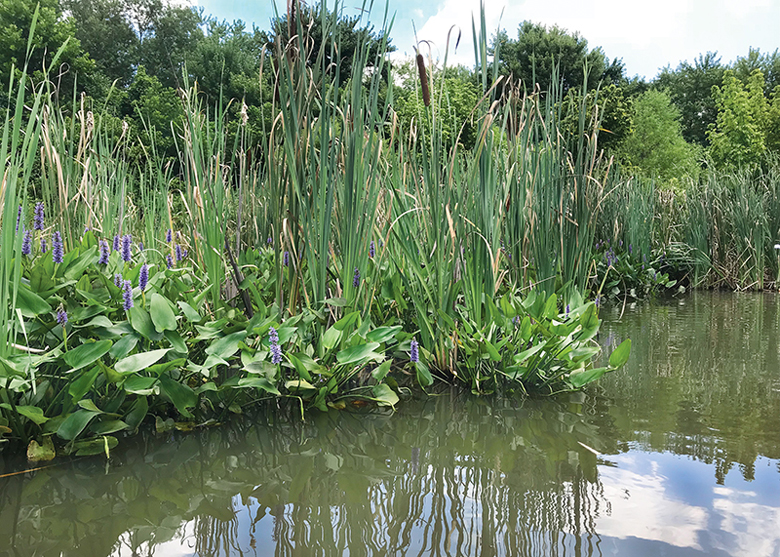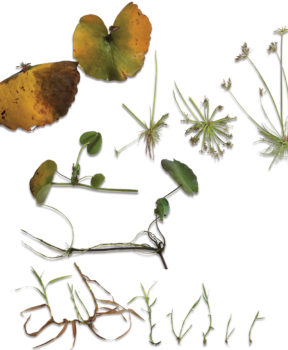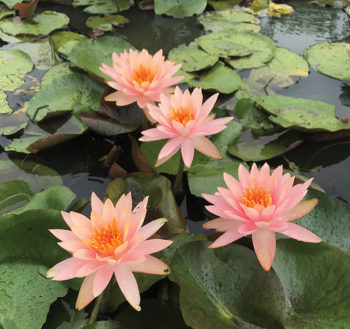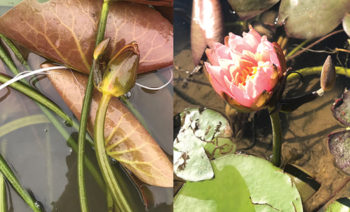
Life will find a way, as Jeff Goldblum’s character in Jurassic Park famously said. The need to reproduce is a basic motivation that drives all life on Earth, and modern aquatic plants have demonstrated this better than most of Earth’s other creatures. In fact, they have found several ways, which I’ll shine a light on here with a couple of examples of plants for which even two reproductive strategies are not enough.
The two forms of reproduction used by most aquatic plants are classic sexual reproduction, or pollination, and one or many forms of vegetative propagation. Vegetative propagation is a broad category describing various forms of asexual reproduction, resulting in the creation of clones of the parent plants.
Propagation Nation
The most common forms of natural vegetative propagation that we see in the pond trade involve the formation of tubers, (e.g., Nelumbo, tropical Nymphaea) stolons and runners (e.g., Nymphoides) and rhizomes (e.g., hardy Nymphaea, iris and Typha).
Sexual reproduction is a superior method of propagation, because the population benefits from the exchange of genetic material. Greater genetic diversity leads to greater resistance to disease and adaptability to changes in the environment. Conversely, most forms of vegetative propagation simply produce clones of the parent plant. This offers the plant a faster strategy to colonize an area with good growing conditions and allows it to produce fewer but larger offspring with a higher likelihood of reaching maturity than seedlings. But, this comes at the cost of possibly reducing the genetic diversity of the overall population. By taking advantage of both sexual and vegetative methods, plants can establish themselves quickly in a particular area, maintain genetic diversity and extend their range to new areas.
For those who produce cultivars of waterlilies or lotuses with very specific characteristics, vegetative propagation is a major key to maintaining the purity of a cultivar. Another vegetative strategy we growers may exploit is a fascinating process known as vivipary. There is more than one definition of vivipary in the world of botany. The narrower definition describes true vivipary as a form of sexual reproduction whereby germination takes place while the seeds are still attached to the parent plant; pseudo-vivipary, on the other hand, is the formation of plantlets in place of sexual reproductive structures. The wider definition, which I will focus on in this article, includes any scenario in which plantlets are formed while still attached to the parent plant.
Waterlilies

In addition to the production of tubers or rhizomes, some species of waterlily also create fully formed plantlets from either the leaves or the flower.
Nymphaea micrantha is an African waterlily species that produces plantlets from the center of the leaves. These plantlets start from a small, gelatinous nub at the center of the leaf. N. micrantha utilizes this strategy to such a degree that the plantlets even produce plantlets of their own while still attached to the parent plant.
More than 30 tropical waterlily hybrids employ this method of propagation to a lesser or greater degree, and all those are descendents of N. micrantha. Some popular examples are N. ‘Lindsey Woods’, N. Panama Pacific, N. ‘Daubenyana’ and N. ‘Margaret Mary.’
In hybrids, production of these plantlets seems to be triggered by the decaying of the parent leaf. Plantlet formation can even be induced by removing the leaf from the parent plant. With the right growing conditions, this can be used as a viable way of propagating certain hybrids. Sean Stevens describes a method where the leaves are removed from the parent plant and placed on the bottom of a 35-gallon propagation tank under artificial lights. He reports that the plantlets started developing within days, and in just a few weeks’ time, they were large enough to be transferred to individual pots.
Some hardy waterlily cultivars display a form of vegetative propagation that more closely resembles pseudo-vivipary. These plants produce plantlets directly from the flower. Two slightly different forms of this have been observed.

In the first form, the plantlet grows from the side of the flower bud. In this case, the plantlet starts to form before the parent flower even opens. What I have found in observing this behavior in N. ‘Colorado’ is that these plantlets often form blooms of their own before they form roots or leaves. The parent flower’s ability to produce pollen and seed does not appear to be inhibited.
In the second form, the plantlet grows from the center of the bloom. In this case, the reproductive parts of the flower are modified, and the development of the plantlet replaces the flower’s ability to produce pollen or seed.
Many of the hardy hybrids that use this strategy can be directly or indirectly linked to Nymphaea mexicana. N. mexicana has been observed to produce plantlets off the flower, but it is very rare. The hybrids that don’t have a clear link to N. mexicana are descendants of N. ‘Colonel A.J. Welch’ or N. ‘Perry’s Fire Opal.’ Unfortunately, according to the Water Gardeners International (WGI) list of names, both of these varieties have gaps in their genealogy.
Some examples of hybrids that have exhibited this behavior are N. ‘Barbara Dobbins’, N. ‘Cherokee’, N. ‘Georgia Peach’, N. ‘Innerlight’ and N. ‘Colorado.’
The Big Question
So, what triggers this behavior? Can it be induced, as it is in tropical hybrids? It is not commonly observed in any naturally occurring species of the subgenus Nymphaea. The one species that this has been recorded in appears to exhibit this behavior far less frequently than the descendant hybrids. This is the opposite with N. micrantha, which propagate from the leaves more readily than its descendants. This could mean that the formation of plantlets from the flowers in hardy waterlilies is more of an artifact of hybridization than a naturally developed strategy.

This is not to say that this strategy doesn’t occur in the wild. Pseudo-vivipary off the flowers in waterlilies has been observed in N. lasiophylla and N. prolifera; however, these tropical species are in the subgenus Hydrocallis and are not known to have been used in propagation. In both N. lasiophylla and N. prolifera, this vegetative propagation replaces sexual reproduction to the point where these plants in the wild rarely produce seed. Instead, they produce several generations of clones without leaving the parent plant.
Without knowing what triggers vivipary in hardy lilies, it is less likely to be a reliable propagation method for growers. I am currently experimenting with some N. ‘Colorado’ plantlets that were removed from the parent plant at different levels of development. These plantlets don’t seem to develop any substantial roots while still attached to the parent plant, so because of this, they don’t get established as easily. One curious thing that I’ve noted is that the first flower of the plantlet often doesn’t look like N. ‘Colorado.’
Sedges
Several species of the sedge family (Cyperaceae) also exhibit alternate propagation strategies where new plantlets are grown from the base of the inflorescence or from the stems.
Umbrella palms Cyperus alternifolius and C. involucratus, Dwarf Papyrus (Cyperus isocladus) and Giant Papyrus (Cyperus papyrus) will produce new growth from the base of the inflorescence. This occurs mainly when the inflorescence is brought in contact with water. It’s not necessary to remove the stem from the parent plant to trigger this behavior. In C. isocladus, I have even seen it occur when the stem was merely bent down without actually touching the water.
A different member of the Cyperaceae family uses a slightly different strategy. Dwarf Bamboo (Dulichium arundinaceum) creates plantlets along the stem when floated in water. The plantlet will sprout from between the segments of the stem.
To encourage this behavior, simply bend the stems downward so that at least part of the stem is floating horizontally. Once the new plantlets have formed, the parent stem can be cut off and pushed gently or slightly submerged into wet soil.
Nymphoides
Several species of the genus Nymphoides are also known to propagate viviparously by production of plantlets from leaves separated from the parent plant. This is part of why N. peltata (floating heart) can be so invasive and difficult to remove in earth-bottom ponds. The native water snowflake (N. cordata) also exhibits this behavior.
These propagation strategies allow aquatic plants to multiply quickly and take advantage of good growing conditions. It is not surprising that these plants have gotten so creative. In a natural environment, good growing conditions can be limited by many factors, such as water depth, clarity, temperature, sunlight, nutrients and predation. Plants are constantly jockeying for position, especially at the water’s edge, and they use these vegetative propagation strategies to try to outcompete their neighbors. As growers we can use these behaviors to our advantage, and we may even enhance or inhibit them through hybridization.


